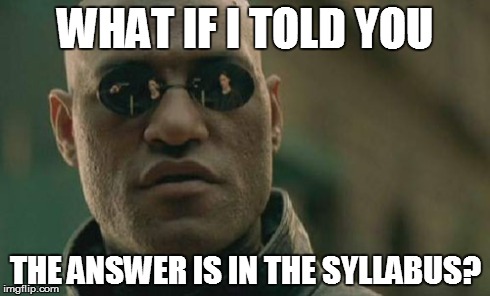As the winter break draws to a close, I’m revising and editing my syllabi for the upcoming semester. Actually, I’ve already finished them, but as I was working on them this week, I pondered what this exercise means in the 21st century. With “outcomes goals” and various other statements added to syllabi, the question I’m considering is for whom am I writing these? The answer should be for my students. But increasingly, I wonder if I’m the only one who thinks that.
I’m old school–I remember a time when the only copy of the syllabus you got was the one the professor handed you on day one of the course. Lose it, and you had to depend on the kindness of your classmates to figure out what you had to do and when. In those days–which I’m certainly not calling the “good old days”–syllabi were lean, rarely stretching beyond two pages. The top of the syllabus had the course number, title, professor’s name and office hours, and this information was followed by a list of books and dates for assignments. Rounding it all out was the date for the final exam and the professor’s weighting of the grades.
I largely adhere to that format, but I, like most of my colleagues, have expanded on the basics. I include a statement about what the course will cover in general. I add information about what should be in a research or reaction paper. I clearly state my policy on extensions (rarely granted) and my loyalty to the institution’s Honor Code.
And I’ve gladly added some information at the behest of various administrative offices, most notably the information pertaining to accommodations for students who require them. Our Office of Disability Resources helpfully supplies faculty with a draft paragraph, and I’ve edited it to reflect my style.
But now that we’ve entered the age of assessment, I find that school, state, and regional accreditation bodies require me to add sections to my syllabus to describe how my course will satisfy a set of goals determined by a committee overseeing the type of course I’m offering. For example, my RELG 278 course, Religion in America After the Civil War, is designated as a Writing Intensive course, a General Education Course (in the Human Experience and Society category), and, oh right, a Religion course. Each of these designations means that I must add a paragraph (even just a brief one) explaining how my course will satisfy each designation. Then I must save my course in a pdf with a particular citation style and send a copy to our office manager, who then compiles all of the department’s offerings and sends them off to the dean and the assistant provost for institutional effectiveness and assessment.
So writing paragraphs isn’t the most onerous task I have ever faced as an academic, but the inclusion of this material in a document I primarily view as a road map for my students makes me begin to understand why there’s now a cottage industry of memes devoted to lamenting how students don’t read the syllabus.




I try to find better ways to make sure my students read the syllabus, including making it the home page of the course’s Canvas site. But as I inserted the assessment paragraphs this time around, I realized that at least a part of the problem is that if I put the “course outcomes” on the first page, the stuff the students care about–where do I find the reading? when is the next paper due?–gets pushed back, further and further into the document. I’m not saying that students need to be able to read the entire document–oh wait, I am–but it doesn’t make sense to bury the critical information for the primary consumers of that information.
So with the last syllabus I drafted for the semester, I engaged in just a tiny bit of subversion. I moved the outcomes statement to the end. For my RELG 250 class, African American Religions–an Honors course, a General Education course, and, oh right, a Religion course–the statement follows the schedule, the grading policy, the information on research paper options, and the contact information for the Office of Disability Resources.
So now two things remain to be seen. One, does it help the students? And two, will the administration notice and/or care? I’m betting the answers are 1) yes and 2) no.

